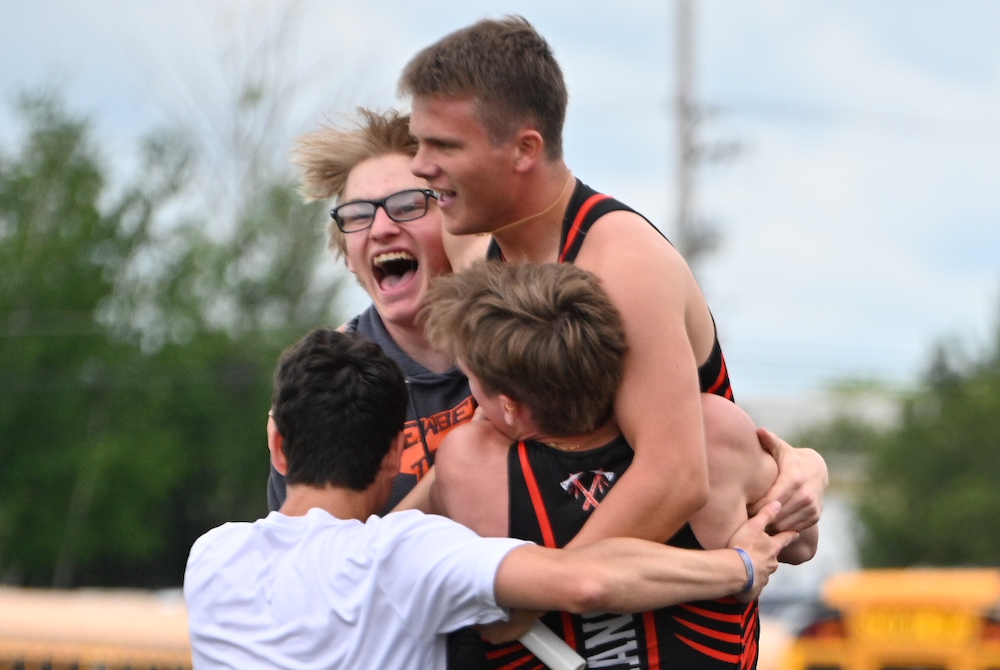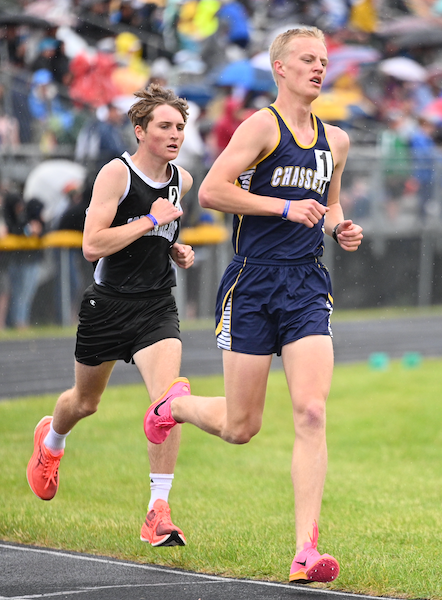
Keep on Coaching
February 1, 2013
By Geoff Kimmerly
Second Half editor
A few weeks ago, I finally got my first chance this season to watch a friend coach his basketball team. After guiding some others at the lower levels, this is his first time running the varsity – something he wasn't sure he wanted to do with a 1-year-old just learning to walk, but a challenge he ended up taking on to the benefit of all those involved.
Simply put, he’s good. I've seen a lot of teams and a lot of coaches over the past 15 years, and although I wouldn't know much of what to do if I were walking the sideline, I felt pretty qualified in telling him I was impressed – even if he didn't buy that I was offering an unbiased opinion. The best news is he’s gone from not sure about this a few months ago to talking about next season.
We know, at least anecdotally, that coaching continues to get more challenging. The time commitment has grown substantially to make running a program a year-round endeavor in a lot of sports at a lot of schools.
That commitment – especially for coaches with children of their own – was a main reason referred to in a New Haven Post-Chronicle story Saturday that noted 23 football coaching openings in Connecticut at one point this offseason. That state has 146 football teams – meaning roughly 15 percent will have new leaders this fall.
And that got me thinking about my friend, about how glad I am he’s given this a shot, and how I've seen so many others either not do so, or not stick around long despite having some pretty nice success.
A study published last winter in Interscholastic Athletic Administration magazine – a product of the National Interscholastic Athletic Administrators Association – noted some predictable results of a study that sought to determine the biggest challenges faced by first-year high school coaches.
The toughest according to the study was balancing the demands of coaching and teaching, experienced by nearly half the respondents – 98 percent of which coached high school teams and 81 percent of which are teachers.
The next six reasons all were noted by at least 30 percent of those in the study – personal fatigue, securing community support, securing and caring for facilities and equipment, parental contact, keeping non-starting players motivated, dealing with schedule interruptions and motivating athletes to achieve consistent, peak performance.
Nothing there is earth-shaking, and most if not all of these challenges are faced by high school coaches regardless of how long they've been in the field. But I got a little more perspective from some of the 32 items that ranked as least challenging to the first-year leaders – keeping in compliance with state and league regulations, dealing with substance abuse issues, teaching sport skills and creating a positive team atmosphere – things that seem most important, and yet appear to be easiest to do. I’m not sure what that tells us – but I think it tells us something.
Click to check out the entire three-page breakdown of the study, plus the researchers’ recommendations to remedy some of what first-year coaches face.
Giving back to Saginaw
I love reading about high-level athletes – like a star-studded group of alums from Saginaw – giving back to where they got their starts.
Pittsburgh Steelers star LaMarr Woodley made a big impact before the start of this school year by donating $60,000 to cover all participation fees for athletes in his former school district. The Saginaw News’ Hugh Bernreuter writes today about how Woodley (Saginaw High), the Philadelphia 76ers’ Jason Richardson (Saginaw Arthur Hill) and former Oakland Raiders standout Stu Schweigert (Saginaw Heritage) have combined to give more than $865,000 back to their home communities.
Bernreuter also mentions the non-monetary contributions of the Golden State Warriors’ Draymond Green (Saginaw High) and former Indianapolis Colts receiver Blair White (Saginaw Nouvel).
Click to read more about it.
Quote(s) of the Week
While rifling through more papers on my desk, I found an article from the Washington Post from Sept. 2011 titled “How high school sports save our schools.” I was drawn to it in part because I spent more than a decade in a newsroom, and it was a piece by a reporter covering education who instead of reporting on school boards and the like, delved into the importance of interscholastic athletics to education as a whole.
He spoke of how participation continues to grow even as resources dwindle, and of data supporting that extracurriculars like sports are more effective than academic classes in teaching leadership, teamwork, time management and “other skills crucial for success in the workplace.” Later, he mentioned a study noting that those who participate in extracurriculars earned more a decade later.
Click here to read the entre piece. These passages struck me most.
“Coaches might be the only faculty members still allowed by our culture and educational practice to get tough with students not making the proper effort. They have the advantage of teaching what are essentially elective non-credit courses. They can insist on standards of behavior that classroom teachers often cannot enforce because the stakes of dismissing or letting students drop their courses are too high. …
“Students do better in activities they choose. If we provide more of them, led by committed adults … that can make a difference. We know the bad news about education. Dropout rates are high. Achievement scores are stagnant. But sports participation is going up, despite pressure to cut it back. Let’s cheer about that and look for a way to draw in more students.”

With 2nd Place in Final Race, Newberry Clinches 1st in Final Team Standings
By
John Vrancic
Special for MHSAA.com
June 2, 2024
KINGSFORD — The race for the Upper Peninsula Division 3 boys track & field championship came right down to the wire Saturday as Newberry edged St. Ignace 96-92 for top honors.
Third-place team finisher Lake Linden-Hubbell won the day’s final race, the 1,600-meter relay, in 3 minutes, 41.94 seconds, and Newberry hung on to edge St. Ignace by two steps for second place and its first title in eight years.
Newberry, which was runner-up to Munising last year, was clocked at 3:43.07 in the 1,600 relay on this sunny and mild late afternoon. The Saints finished nine hundredths of a second later.
“We knew we had to beat St. Ignace to win,” Newberry senior Kennedy Depew said after finishing the anchor leg. “This was my last race ever. I knew I had to give it my all. That’s also why I knew I had to scratch from the open 400. I would have been in four events. I think scratching from the 400 helped me save some energy. We weren’t satisfied with runner-up last year, which makes this year’s championship all the more satisfying.”
Classmate Gabe Luck provided Newberry with its lone individual first with a heave of 44 feet, 1¾ inches in shot put.
“We had a lot of injuries this year,” Newberry coach Drew Schultz said. “For all the obstacles we had, we wouldn’t have it any other way, having two of the best athletes decide it in the last race. I’m extremely proud of our guys. To win it that way is just insane. I’m proud of all our eastern-end kids.”
 Depew also was runner-up in the 100-meter dash in 11.63 seconds.
Depew also was runner-up in the 100-meter dash in 11.63 seconds.
Senior Jon Ingalls, who ran the last leg for the Saints, won the 110 hurdles (16.39) and 300s (42.89) and helped them place second in the 400 relay (45.94).
“Both hurdles were decent,” Ingalls said. “Those weren’t my best times, but it feels good to grind out a few more wins.”
Senior Owen Lester also provided the Saints with a victory in pole vault (12-6).
LL-H got firsts from senior Gabe Popko in discus at 153 feet, 4¼ inches, and classmate Matt Jokela in the 400 (51.09). Jokela also took third in the 100 (11.65).
“Real good hydration and confidence are keys,” Jokela said. “I think having confidence helps a little. I usually don’t go too hard out of the blocks. Then, I usually try to go as hard as I can in the last 200.”
Chassell junior Kalvin Kytta claimed three firsts, taking the 800 in a personal-best 2:03.62, 1,600 (4:39.58) and 3,200 (10:27.32).
“Three wins, I’m pretty happy with that,” he said. “The 800 went real well. Overall, I’m very happy with my performance today.”
Fourth-place Bessemer set UPD3 Finals records in the 400 relay (45.3) and 800 (1:34.64). Powers North Central previously set the record in the 400 (45.34) two years ago and Rock Mid Peninsula had held the 800 record since 2001 when it ran a 1:35.1.
“We shaved two seconds off in the 800 relay which feels good, and our handoffs in the 400 were good all year,” Bessemer senior Landon Peterson said. “Our school record in the 400 is 44.98, which is something we’ve done three times this year. Running on a rubber track gives you a much better grip, which helped us a lot today.”
Bessemer senior Tom Trudgeon became a four-event winner, also taking the 100 (11.46) and 200 (23.85).
Crystal Falls Forest Park freshman Vic Guiliani won high jump (6-0), and sophomore Michael Rexford went 19-9 in long jump, providing Escanaba Holy Name with its first U.P. Finals title since the school reopened in 2021.
PHOTOS (Top) Newberry runners celebrate taking second place in the 1,600 relay, allowing them to finish ahead of St. Ignace for the team title in Upper Peninsula Division 3. (Middle) Chassell's Kalvin Kytta and Cedarville/DeTour's Ethan Snyder lead the pack of 1,600 runners. (Click for more from Cara Kamps/RunMichigan.com.)

